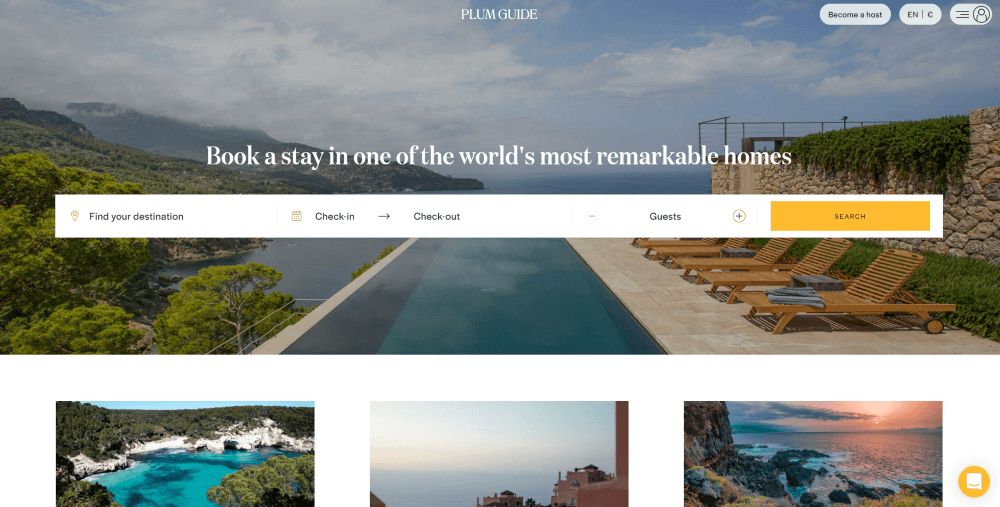Plum Guide: The Listing Site for Luxury Vacation Rentals
Most vacation rental hosts know about Airbnb, Vrbo, Booking.com and Expedia, which offer marketplaces for owners and hosts to advertise their properties to guests.
But what if you own an exceptional property that you feel deserves to be highlighted as such; how can you stand out from the crowd? That’s where Plum Guide comes in. This new online travel agency (OTA) offers a niche platform for lavish and opulent rentals.
What is Plum Guide?
As a newer OTA, Plum Guide is grabbing the attention of hosts and guests alike. Plum Guide, which was originally named PLU&M for “People Like You and Me”, was launched in 2016 and is based in London. Creating its own “Michelin Guide” of vacation rentals, it aims to bring luxury vacation rental stays to travelers worldwide.
It offers 12,000 hand-picked vacation rentals in locations across the UK, Europe, the United States, Israel, Turkey, Barbados, and Mexico. The website gets about 410,000 monthly visitors, with most of the traffic coming from the UK and the U.S. They claim only 3% of all short term rentals make the cut to be included in their growing portfolio of exclusive houses, mansions, castles, villas, estates, houseboats, penthouses, luxury apartments and more.

How does Plum Guide work?
If you’re keen to list your property on Plum Guide, get ready to step up your game. On the surface, Plum Guide works like every other listing site, except for the fact that they have a rigorous screening process to be considered for the platform.
They screen both the host and the property to see if they match all of the 150 criteria for being listed on Plum Guide. If you’re approved as a host, you can’t automatically list multiple properties. Each luxury place you wish to list has to go through the same analysis.
If you’re considered as a host, Plum Guide will send a representative to your front door to inspect the property with an extensive checklist that ranges from measurable criteria, such as wifi speed and decibel levels in each bedroom, to “feel” criteria, such as design aesthetic, sociability of the space, and pillow comfort.
Once you are approved by Plum Guide themselves, only then can you list your property and join the exclusive group of hosts. One great thing about being on Plum Guide is that they will set up your entire account for you. When you enter your information, they will create the description and details and send a photographer to take pictures. Their website has to uphold their editorial standards, so they want to guarantee that your listing will be up to par.
Plum Guide has a slightly higher price point than most other OTAs – as we will explain in our following chapters – due to the grandeur of their collection. However, this can also be a great opportunity to make some extra revenue and earn your property recognition as being among the creme de la creme of vacation rentals.

Why you should list on Plum Guide
Plum is an exclusive listing site, with only 3% of homes making the cut, so it is not easy to get listed on the platform. What are the benefits of listing your rental on this guide? Is it worth it? Let´s explore.
Less management
As you know, managing a vacation rental business can be a lot of work, especially if you have listings on multiple websites. Often, you will have to put in the time to check reservations and guest communications on every platform or pay to use a channel manager system. Also, optimizing each listing while keeping everything consistent can take some effort. Fortunately, on Plum Guide, they take care of many of the managerial aspects of running a vacation rental business for you.
When setting up your account, you will be prompted to enter your iCal links so Plum Guide can update your calendar with availabilities and reservations from every place where your home is listed. This feature is very helpful with managing across platforms, but it does not work as well as an API channel manager where calendar updates happen instantaneously, like what many vacation rental softwares have.
Without using a channel manager, you would have to go to every OTA and block out days on each individual calendar yourself. This needs constant attention and can often lead to double bookings and cancelations. You don’t even have to pay anything extra for this feature on Plum Guide, so it’s free basic management software for the price of receiving bookings.
If your property makes it onto Plum Guide, you automatically get a digital concierge service for your listings. This service is completely free and works to drive business to your property by guiding ‘the right’ guests to your home. This helps increase the number of bookings.
On most other listing sites, you have to optimize your profile and listing, run discounts and promotions and receive the best reviews in order to gain customer trust and get more bookings. This is obviously a lot more work to do yourself than having a dedicated service at your fingertips that will drive traffic to your listing. You almost don’t even have to do any management on Plum Guide except for message and receive guests.
It’s important to note, however, that if you choose to list on other platforms, as well as on Plum Guide, you will still need to do management and upkeep of profiles to ensure that pricing, calendars, and information match on all websites in order to receive bookings.
Recognition
For a website to refer to itself as the “Michelin Guide of vacation rentals”, there has to be some recognition that comes with being listed on its website. Only the top 3% of vacation rentals in your location will make it through the testing phase to be Plum Guide approved, so already your home can claim to be the best of the best just by being approved by the platform.
On top of that, they have also created the Plum Award badge to acknowledge homes that pass a rigorous four-step process. This badge is valid for as long as you list on Plum Guide and upkeep the set standards for being an award recipient. The best thing is that the Plum Award is recognized separately from the Plum Guide, meaning your home stands out to possible guests on every listing site where you choose to display the badge.
Listing on Plum Guide gives your home recognition beyond the website itself. Your home will be on the shortlist of best vacation rentals in the world. Making the top 3% of homes is a huge accomplishment, and people will think highly of this distinction.

More reliable guests
Plum Guide claims that the guests you receive on their website are more reliable and trustworthy compared to other platforms. Plum Guide’s target audience is the “mature urban creative”, which means they are between the ages of 35-55, live in big cities and have an interest in the arts. Many other OTAs have people between the ages of 24-34 as their biggest segment of users and as their target audience.
When renting out your own home as a short term rental, many people fear that guests will not respect their property and it will sustain damages from misuse. Plum Guide claims that because their target audience is a more sophisticated and mature crowd, they are less likely to hold a house party or leave your property in ruins.
Guests who book through Plum Guide also cancel 30% less compared to other platforms, according to them. Guest cancellations can leave hosts with an empty rental during peak season and can lead to a loss of revenue. Hosting on Plum Guide means you’re more likely to have responsible guests follow through with bookings to ensure a fully booked calendar.
Frequently asked questions about Plum Guide
We’ve gathered some of the most frequently asked questions about Plum Guide, so you can understand what listing on this channel entails.
What makes Plum Guide different from other OTAs?
At its core, Plum Guide is not that different from other OTAs. They serve as a marketplace that connects travelers with vacation rentals. The most obvious difference that sets Plum Guide apart from the rest is its focus on only luxury homes. Unlike other platforms, they screen each rental against a set of criteria to ensure that they only advertise the best of the best. If you want to see how Plum Guide compares to other vacation rental booking platforms, read our detailed section on this topic here.
Can you continue to host on multiple platforms while on Plum Guide?
Of course! Plum Guide does not require its hosts to be exclusive to the OTA. They only ask that you sync your calendars through iCal to easily manage listings across platforms and avoid double bookings. iCal is used by many other platforms such as Airbnb, Booking.com and Vrbo. All you have to do is paste your iCal link from the other platforms into your Plum Guide account when you join.

What happens if you don’t respond to a booking request in 24 hours?
We all know that fast response times are a must for every host wanting to provide top-notch service to their guests. If your listing on Plum Guide is set to Request to Book, then you only have 24 hours to give a confirmation or a rejection to the people wishing to reserve your home.
If you haven’t responded in 24 hours, the concierge at Plum Guide will try to get hold of you, and if that is not possible, then they will start to look for other comparable accommodations for the guest. An easy way to avoid this is by switching your listings to Instant Booking.
Are you able to screen potential guests?
Plum Guide has a thorough ID verification system in place for you to use if your home is set to Instant Booking, as well as anti-fraud protection. Beyond those measures, it is against Plum Guide’s policy to discriminate against guests due to race, gender, sexuality, religion, disability, or identity. If someone passes the verification test, it’s safe to assume your potential guest is fit for the stay.
How much does it cost to list on the Plum Guide?
Plum Guide offers two fee options: a split-fee structure and a host-only structure. With the split-fee structure, hosts can expect to pay 3%, and guests can expect to pay around 12% of total accommodation charges. The host-only structure will cost the host around 16.5%-18.5% of total accommodation charges. Plum Guide also requires a one-time onboarding fee. Find out more about Plum Guide fees here.